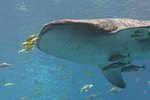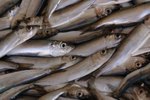Things You'll Need
Fertilized sea urchin eggs
Small nursery tank
Larger nursery tank
Tank with established bacteria substratum
Algae/plankton diet
Large tanks with corrugated sides or landlocked saltwater pond
High protein pelleted feed
Tips
Nursery tanks should be kept at approximately 70 degrees Fahrenheit.
Salmon farms in Scotland have had success feeding sea urchins in the same ponds as salmon, allowing them to eat leftover fish food and natural algae.
According to aquaculture researchers in the Bowdoin Biology Department, sea urchins kept in cool water grow slower and produce less roe but are less susceptible to disease.
A more cost-efficient, if less environmentally friendly, method of sea urchin farming involves skipping the nursery / larval phase by collecting wild urchins and placing them in grow-out tanks or coastal cages for several months of fattening up before harvesting.
Sea urchin gonads, or "roe," are considered delicacies in Europe, Japan and Asia. Known as "uni," urchin roe can demand a high price. Unfortunately, stocks in many coastal waters have become seriously over-fished, and the harvesting practice known as dredging negatively impacts the sea urchin's ecosystem. Aquaculture of the more popular species of sea urchin may be the answer to meeting consumer demand without depleting the ocean. However, the science of "echiniculture" is still in its infancy, and it can take several years, from egg to urchin, to produce a viable harvest.
Nursery
Place larvae in a small nursery tank, approximately one larva per milliliter of saltwater. Provide water circulation at approximately 20rpm. Avoid bubbling air, as bubbles seem to damage larval spines.
Three days after hatching, begin to feed the tank with single-celled algae. Feed only as much as they will eat in 24 hours (approximately 3,000 algae per milliliter of seawater).
Perform a 10 percent water change daily, carefully siphoning out uneaten food and dead larvae.
Move larvae to larger tank, approximately one larva per 10 milliliters of saltwater, after 10 to 15 days and continue to feed well and perform daily water changes until larvae are full grown at three to four weeks.
Move grown larvae to a well-established aquarium with biological and/or mechanical filtration and mature bacterium in the substrate to induce metamorphosis. The process of metamorphosis takes about five days.
Feed small sea urchins a phytoplankton diet. Substrate-dwelling diatoms work best. After approximately one year, the juvenile urchin will be large enough to accept adult food.
Grow-Out Phase
Place sea urchins in large, well-filtered tanks with corrugated sides for climbing or in a landlocked saltwater pond. Do not overcrowd.
Feed them a high-protein, sinking, pelleted food supplemented by sea kelp.
In six years or more, when an urchin reaches sexual maturity, it will produce roe every six to 12 weeks. However, the urchin must be cracked open and killed to harvest the roe.
References
Tips
- Nursery tanks should be kept at approximately 70 degrees Fahrenheit.
- Salmon farms in Scotland have had success feeding sea urchins in the same ponds as salmon, allowing them to eat leftover fish food and natural algae.
- According to aquaculture researchers in the Bowdoin Biology Department, sea urchins kept in cool water grow slower and produce less roe but are less susceptible to disease.
- A more cost-efficient, if less environmentally friendly, method of sea urchin farming involves skipping the nursery / larval phase by collecting wild urchins and placing them in grow-out tanks or coastal cages for several months of fattening up before harvesting.




